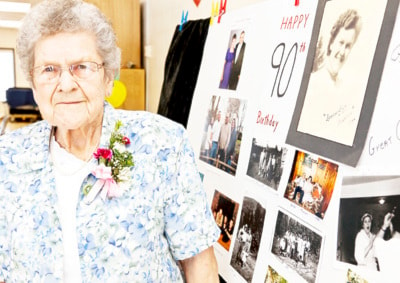It is amazing what can be accomplished with some hard work and dedication. For years Marion Sallenbach ran the Lake Country Calendar with a Gestetner copying machine and a small army of volunteers on behalf of the Ladies’ Hospital Auxiliary.
It was 1944 when Sallenbach moved to Winfield as a young married woman. While raising a family she still found the time to devote to major projects and be a vital part of the community.
This weekend Sallenbach’s 90th birthday was celebrated at the Winfield Seniors’ Activity Centre, but she took a few moments to recall her role in Winfield’s media history.
The Lake Country Calendar first went to press in February 1951, and in March 1973 the Winfield Women’s Institute sold the newspaper to the Winfield Ladies’ Hospital Auxiliary, of which Sallenbach was a part.
The auxiliary was looking for a way to raise funds. The concept was the same as all publishing businesses—sell ads, create some content and distribute the newspaper.
Sallenbach says the Calendar was primarily about advertisements in those days. “We used to put in birthdays and deaths, then we would go out to businesses and get ads.”
One lady ran the books, two collected ads and money and two to three ladies ran off copies of the paper on the Gestetner.
While the concept was simple, the execution was anything but.
The ads were done up on slips, printed out and then stencils were created. It was incredibly time consuming and Sallenbach’s daughter, Jo Anne Galigan, remembers being drafted to the cause in her family home. “I remember having to collate the paper, we still have the original equipment in the basement.”
Eventually, the newspaper outgrew the Sallenbach home and collation of the pages was moved to the Winfield Memorial Hall.
“For quite a while, the Girl Guides helped put the papers together,” Sallenbach recalled.
“We would have stacks of pages on tables around the hall, the girls would take sheets of paper off each pile and put the paper together.”
The paper was delivered to mail boxes, the Post Office provided correct counts of the number of boxes. Towards the end of the Ladies’ Auxiliary involvement, the Calendar was 25 to 30 pages long on eight and a half by eleven inch paper.
“When we started there were not too many pages, but it grew and when we took over it kept growing,” explained Sallenbach.
The Calendar was, by any account, very successful. Sallenbach says thousands of dollars were raised for the Kelowna General Hospital. The precise financial details of the Calendar and how much money was raised are detailed in the minute books of the Ladies’ Auxiliary, and Sallenbach remains happy with the results of so many volunteers.
The Calendar was sold to John Gable and Jack McCarthy, who began publishing with their first issue in October 1979.
Sallenbach says the decision to sell the paper was based on long-term financial reasons.
“They were going to start a paper and we couldn’t compete. We did make a lot of money, but they offered a fair amount for the paper. All that money went to the Kelowna Hospital.”
Sallenbach enjoyed her time organizing and publishing the Calendar, despite the incredible busyness of it all. “It was interesting—something different to do.”
Today, she remains as active as ever with charitable endeavors including the Loan Cupboard for medical equipment.
